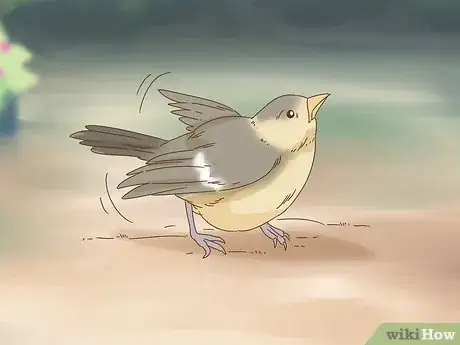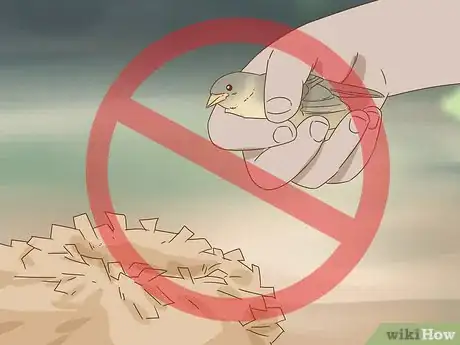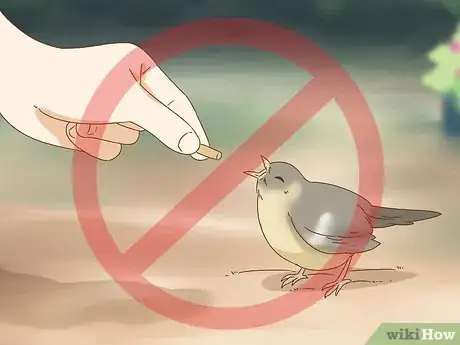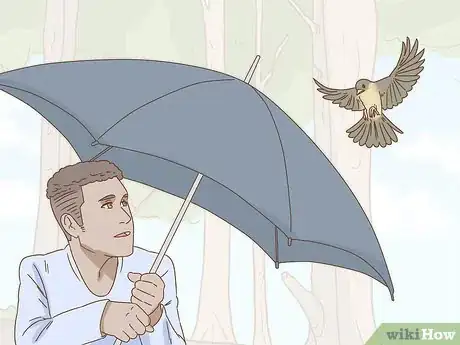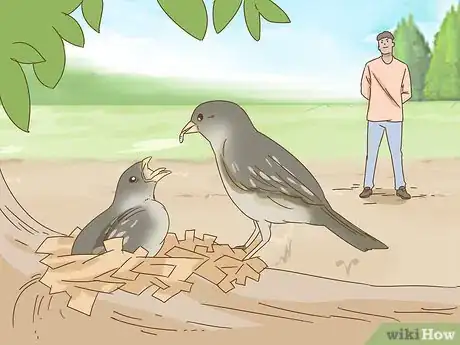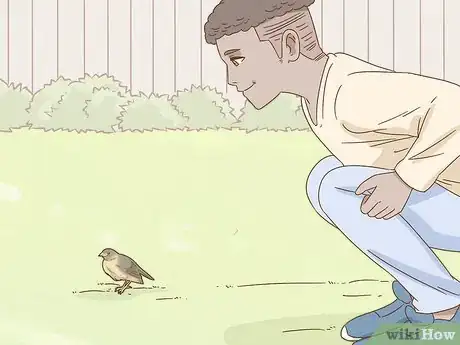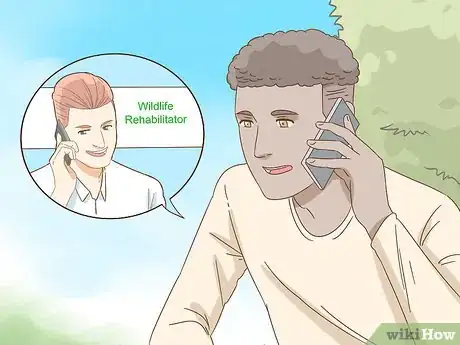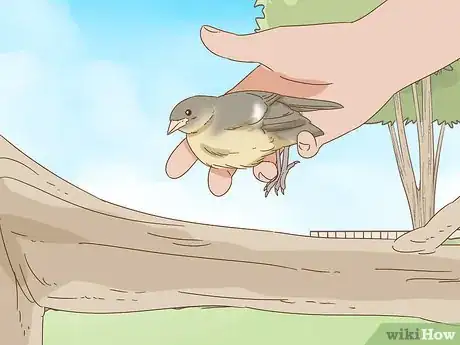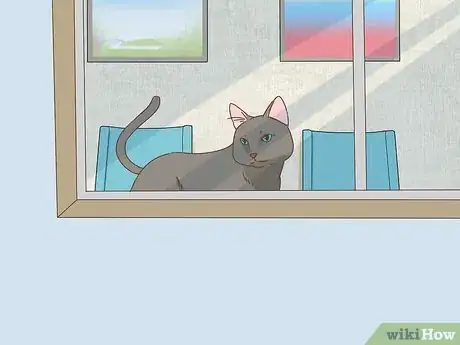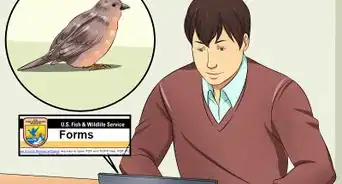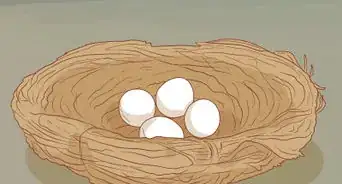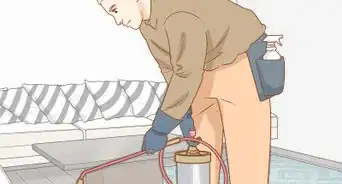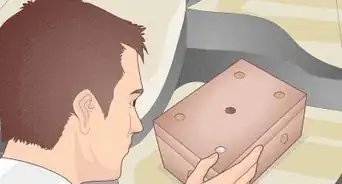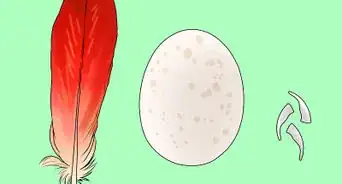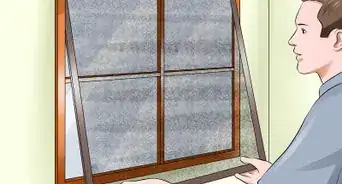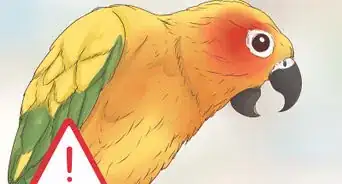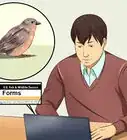This article was co-authored by Jeff Jones. Jeff Jones is a Bird Specialist based in Nashville, Tennessee. He is the writer of BirdOculars, a website dedicated to helping people become better birders. He has over 18 years of experience and specializes in feeding birds and wildlife. Jeff experiments to find ways to encourage birds he wants to study and his website help others to do the same.
wikiHow marks an article as reader-approved once it receives enough positive feedback. In this case, several readers have written to tell us that this article was helpful to them, earning it our reader-approved status.
This article has been viewed 247,774 times.
A fledgling is a juvenile bird that has outgrown the hatchling and nesting stages but may not have learned to fly yet. It’s not uncommon to see fledgling birds on the ground, since many species of birds push their fledgling young out of the nest to help them become independent. So, unlike with fallen nestlings, the best thing to do is to leave the fledgling alone as it learns to fly, after you’ve made sure that the area it’s in is safe. If the fledgling is injured, though, contact a wildlife rehabilitator.
Steps
Assessing the Situation
-
1Determine whether or not the bird is a fledgling. Depending on the bird’s age, it may or may not need your help. Juvenile birds fall into 3 categories: hatchlings, nestlings, and fledglings. Hatchlings and nestlings are baby birds and have no visible feathers on their wings or body. Neither hatchlings nor nestlings will survive for long out of the nest.[1] Fledglings, on the other hand, have feathers and can survive on their own.
- It’s very common for nestlings to be found hopping on the ground as they’re just learning to fly and forage for food. Although it’s normal to feel worried for a fledgling hopping about on the ground, the fledgling might not actually need any help at all.
-
2Leave the unharmed fledgling on the ground as it learns to fly. As long as the parents are observing and frequently feeding the young fledgling, it’s being well taken care of and needs no help from you. For many species of birds, fledglings can spend as long as 1–2 weeks on the ground as they learn to fly. To the casual observer, it can appear as though a fledgling is in trouble even when it’s not. The best thing you can do is leave the healthy fledgling alone.[2]
- If you’re concerned about the fledgling’s safety and health, check on it every 1–2 days to make sure it’s still alive and flapping.
Advertisement -
3Do not place the fledgling into a nearby nest. Even if you see a nest in a nearby tree, do not put the fledgling into it. It’s more than likely that the young bird will just jump back out of the nest. Or, if the fledgling’s parents are in the nest, they may kick it back out a second time![3]
- Furthermore, the next may not even belong to the fledgling’s family or may have been constructed by a different species of bird altogether.
-
4Do not give the fledgling any food or water. Although the young bird may appear small and hungry, resist the temptation to care for it and give it food. Its parents are likely nearby and will be bringing it food from time to time. Similarly, do not try to give the bird water with cupped hands or a water dropper. Finally, don’t pick up the fledgling bird and carry it to a source of water—it could easily be lost or eaten by a predator if you relocate it.[4]
- If a young bird accepts food from humans too many times, it may imprint on humans and struggle to form social bonds with other birds.
-
5Protect yourself from overzealous parent birds. As fledglings flop on the ground while learning to fly, their parents are often observing from up in a nearby tree. Some species of birds—crows, for example—are very protective of their vulnerable young. If the parents think you’re threatening their fledgling, they are likely to swoop down and attack. If 1 or 2 grown birds swoop down at you, avert your eyes and move away, and avoid traveling near the fledgling in the future.[5]
- If you can’t help but walk through the area that the protective birds are patrolling, carry an umbrella with you to keep the birds from pecking at your head and face.
-
6Make sure that the fledgling’s parents are feeding it regularly. Position yourself 20–30 feet (6.1–9.1 m) away from the fledgling and watch the nearby treetops. Sooner or later, 1 of its parents should swoop down with some food. You may have to wait awhile. In some cases, parent birds may only feed their fledglings once every 4 hours.[6]
- If the parents are not feeding the fledgling, try moving a little farther off. The adult birds may not approach if you’re too close.
Helping an Injured or Abandoned Fledgling
-
1Inspect the fledgling to determine whether it’s injured. Walk towards the fledgling until you’re less than 3 feet (0.91 m) away. Crouch down and inspect the young bird for any signs of injury. These can include a drooping wing, visible broken bones, or any signs of blood. Also watch the bird as it moves. If it holds its wings against its sides and doesn’t show signs of pain, it’s probably not injured.[7]
- A seriously injured fledgling may have flies buzzing around or, if it’s in very bad shape, have a few maggots crawling across its body.
-
2Call a wildlife rehabilitator if a fledgling is injured. Wildlife rehabilitators are trained professionals who know how to care for orphaned or hurt fledglings. Also call a rehabilitator if the fledgling doesn’t seem to be injured but appears to have been abandoned by its parents. The rehabilitator will inspect the fledgling and, if needed, can take the bird to a wildlife care center.[8]
- If you live in the United States, you can find a website for wildlife rehabilitators in every state online at: https://secure.mediapeta.com/peta/PDF/WildlifeRehabilitatorsbyState.pdf.
- If you live outside of the U.S., contact your local government or animal-control center and ask about wildlife rehabilitation personnel.
-
3Place a fledgling on a low tree branch if it’s in immediate danger. In some situations, you won’t have time to wait for a wildlife rehabilitator to arrive on the scene. For example, if feral cats live in the area where the fledgling has fallen or if you see a hawks circling, the fledgling is in immediate danger. Gently slide your hand beneath the fledgling, lift it up, and place the fledgling onto a low tree branch or sturdy bush.[9]
- It’s a good idea to still call a wildlife rehabilitator after you’ve placed the fledgling into a tree.
-
4Keep housecats and other pets indoors until the fledgling moves off. Domesticated animals can be dangerous to fledgling birds that are unable to fly. Housecats especially would enjoy toying with and eventually killing a defenseless fledgling. So, if the fledgling is within 1⁄4 mile (0.40 km) of your home, keep all pets indoors for up to 2 weeks, or until the fledgling has flown off.[10]
- If you have neighbors with housecats, advise them to keep their pets indoors for the same amount of time also.
Community Q&A
-
QuestionWhat do you do if you find a baby bird on the ground?
 Jeff JonesJeff Jones is a Bird Specialist based in Nashville, Tennessee. He is the writer of BirdOculars, a website dedicated to helping people become better birders. He has over 18 years of experience and specializes in feeding birds and wildlife. Jeff experiments to find ways to encourage birds he wants to study and his website help others to do the same.
Jeff JonesJeff Jones is a Bird Specialist based in Nashville, Tennessee. He is the writer of BirdOculars, a website dedicated to helping people become better birders. He has over 18 years of experience and specializes in feeding birds and wildlife. Jeff experiments to find ways to encourage birds he wants to study and his website help others to do the same.
Bird Specialist Call your local wildlife rehabilitator and ask for help so you can make sure that the bird actually is abandoned. Many young birds are left alone by parents on purpose in between feedings. This way, the parents don't attract attention to their baby birds.
Call your local wildlife rehabilitator and ask for help so you can make sure that the bird actually is abandoned. Many young birds are left alone by parents on purpose in between feedings. This way, the parents don't attract attention to their baby birds. -
QuestionI found a fledgling on the ground. I tred to pick it up, but it kept hopping away and finally went into the bush. Should I leave it there?
 Community AnswerYes. Sometimes fledglings get stuck on the ground for a couple of days while they are figuring their wings out.
Community AnswerYes. Sometimes fledglings get stuck on the ground for a couple of days while they are figuring their wings out. -
QuestionMy neighbor's cats just attacked a fledgling, but didn't leave any damage, so I brought it inside in a shoe box. What should I do with it?
 Community AnswerIf it didn't leave any damage, release it close to where you found it. If you believe it could have injuries, call the RSPCA or a local vet and they might be able to advise you on what to do or even send someone over to check the bird themselves.
Community AnswerIf it didn't leave any damage, release it close to where you found it. If you believe it could have injuries, call the RSPCA or a local vet and they might be able to advise you on what to do or even send someone over to check the bird themselves.
References
- ↑ http://thewildlife.wbur.org/2014/06/24/when-to-help-a-baby-bird-and-when-to-leave-it-alone/
- ↑ https://www.wildliferescue.ca/blog/tell-fledgling-crow-needs-help/
- ↑ http://thewildlife.wbur.org/2014/06/24/when-to-help-a-baby-bird-and-when-to-leave-it-alone/
- ↑ https://www.audubon.org/news/when-you-should-and-should-not-rescue-baby-birds
- ↑ https://www.wildliferescue.ca/blog/tell-fledgling-crow-needs-help/
- ↑ https://www.wildliferescue.ca/blog/tell-fledgling-crow-needs-help/
- ↑ http://thewildlife.wbur.org/2014/06/24/when-to-help-a-baby-bird-and-when-to-leave-it-alone/
- ↑ http://thewildlife.wbur.org/2014/06/24/when-to-help-a-baby-bird-and-when-to-leave-it-alone/
- ↑ https://www.wildliferescue.ca/blog/tell-fledgling-crow-needs-help/
About This Article
If you've found a fallen fledgling, don't touch or disturb the bird since its parents are likely nearby. Parents usually kick fledglings out of the nest to teach them to be independent, so it's normal for a fledgling to be on the ground. If you see the fledgling moving, shaking its wings, or chirping, give it space and monitor it for a few hours to see if its parents are around. If the fledgling is visibly injured or covered in bugs, contact a local wildlife refuge that specializes in birds to pick it up and take it to a care center. Avoid picking the fledgling up and putting it back in its nest since its parents will likely kick it out again. You can check in on the bird every day for a few weeks to make sure it's healthy and safe. Keep reading to learn how to spot whether the fledgling’s parents are bringing it food!

